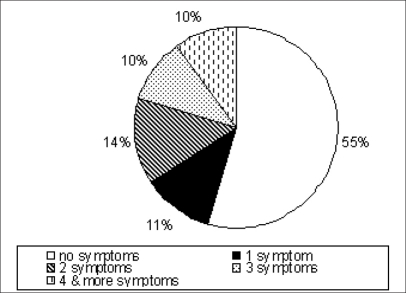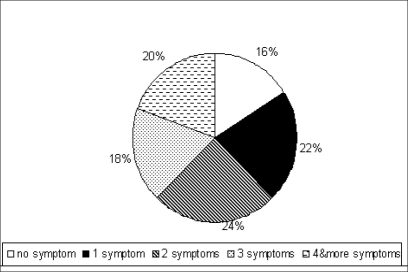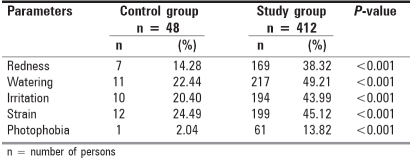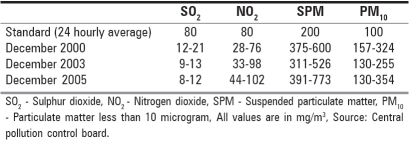Abstract
Purpose:
To study the effect of exposure to high level of air pollution on ocular surface health.
Materials and Methods:
A total of 520 subjects volunteered to participate in this study. All volunteers were required to give a detailed history and were subjected to ophthalmic examination under slit lamp, visual acuity test, tear film break-up time (BUT) and Schrimer's test.
Results:
Significantly high number of subjects in study group complained of ophthalmic symptoms compared to control group. Sevent eight per cent subjects in the study group had symptoms such as redness, watering, irritation, strain or photophobia whereas this number was 45% in control group. Schirmer's test showed a significantly low value of 22.75±8.91 mm in study group as compared to 30.30±7.92 mm in control group (P<0.001). Average tear break-up time in study group was significantly low (P<0.05) with a value of 11.17±2.92 seconds compared to 12.13 ± 3.24 seconds in control group.
Conclusion:
Results of our study indicate that people traveling in highly polluted areas and exposed to high level of air pollutants are likely to suffer from significantly high incidence of subclinical ocular surface disorders.
Keywords: Air pollution, ocular surface disorders, ophthalmic symptoms
INTRODUCTION
Health hazards due to complex problems of air pollution in metropolitan cities are very well-recognized. Vehicular emissions are one of the main sources of air pollution. Rising income and increasing necessity for personal mobility and inadequate availability of mass transportation facility has resulted in a rapid increase in automobile ownership and its utilization in Delhi. Motor vehicles emit carbon monoxide, nitrogen oxide, sulphur dioxide and other toxic substances such as total suspended particulate matter (SPM) and lead. Health effects of air pollution range anywhere from minor irritation of the eyes and the upper respiratory system to chronic respiratory disease, heart disease, lung cancer and death. Though studies have been done on effects of air pollution on the skin,the respiratory and the cardiovascular system in humasn but effects on eyes are not very well investigated.[1–3] The eyes are vulnerable to the effects of air pollution as they are constantly exposed to polluted air and air-borne pollutants are a great threat to eye as a whole and the cornea in particular. There are reports of corneal drying, irritation and itching in the eyes of people exposed daily to traffic emissions. The present study was designed to investigate impact of air pollution on eyes in people exposed to vehicular pollution on a daily basis.
MATERIALS AND METHODS
Apparently healthy adults above the age of 18 years were screened for inclusion in this study at Delhi Institute of Pharmaceutical Sciences, Dr. Rajendra Prasad Center for Ophthalmic Sciences and Venu Eye Institute, New Delhi. Subjects suffering from chronic systemic illness such as diabetes and hypertension, ophthalmic illness except refractive error and subjects using ophthalmic medications were excluded from the study. Subjects with history of autoimmune skin and respiratory disorder and any other disease, which might predispose to dry eyes, were also excluded. All subjects were informed about the nature and method of study and informed consent was obtained.
Subjects were divided into two groups. The study group comprised people who commuted daily via highly polluted areas for at least two years. Control group comprised people residing on the campus and traveling from their houses to workplace within the campus. They were not commuting long distances on a daily basis. The housewives routinely staying indoors at campus houses were also included in the control group.
A detailed history was recorded for all subjects. The history provided information regarding age, sex, profession, distance traveled in km/day, commuting time, mode of transport, period of daily travel in years and the route of travel. History of ophthalmic symptoms such as redness, watering, irritation, strain, blurred vision and photophobia was also recorded. Subjects were assessed for best-corrected Snellen's visual acuity (VA). Ocular examination was done using slit lamp for presence of particulate matter.
Following tests were also performed to assess rate of tear formation and stability of tear film.
Schirmer's test
Standardized filter paper strips (Sno strips; Smith and Nephew Pharmaceuticals Ltd., Romford, UK) were inserted with the head of the strip in the lower conjunctival fornix at the junction of middle and lateral one-third of lower eyelid margin.[4] Topical anesthesia was not used and strips were inserted in such a way that they did not touch the cornea. Subjects were asked to remain relaxed with open lids during the test. After five min, the length of the wett part was measured from the fold on the strip. Wetting of the strip greater than 10 mm was considered as the normal value.
Tear break-up time
Stability of the tear film was assessed by measuring tear film break-up time (BUT). “Flourescein” strips prepared using 1% flourescein solution were applied to superior bulbar conjunctiva. No local anaesthetic was used. The interval between the onset of last complete blink and appearance of first black spot in flourescein stained tear film without touching the eyelid was measured. BUT was measured as the mean time obtained from three blinks. Values over 15 sec were considered as normal.
RESULTS
A total of 520 subjects were enrolled for this study. 441 subjects belonged to the study group whereas 79 subjects were in the control group. The mean age of subjects in control group was 33.57±11.52 years while in study group mean age was 34.18 ± 13.36 years.
A significantly larger number of subjects in study group were suffering from ophthalmic symptoms compared to control group (P<0.001). Symptoms of redness, watering, irritation, strain, blurring and photophobia were absent in 55% subjects in control group while only 22% subjects were asymptomatic in study group [Figures 1 and 2]. In the study group 38.22% subjects had occasional redness of eyes compared to 14.28% in the control group (P<0.001). In the control group other ophthalmic symptoms of watering, irritation, strain and photophobia were observed in 22.44, 20.40, 24.49 and 2.04% of subjects respectively. Corresponding numbers were significantly high in the study group with 49.21% (P<0.001), 43.99% (P<0.001), 45.12% (P<0.001) and 13.82% (P<0.001) respectively [Table 1]. No significant difference was observed in visual acuity in the two groups (P=0.33). Best-corrected VA of less than 6/9 was observed in 22.45% subjects in the study group and 30% subjects in the control group.
Figure 1.
Percentage of subjects showing ophthalmic symptoms in the control group
Figure 2.
Percentage of people showing ophthalmic symptoms in the study group
Table 1.
“Ocular subjective complaints” in the control and study group
The average Schirmer's test value in the study group was 22.75±8.91 mm as compared to 30.30±7.92 mm in the control group (P<0.001) [Table 2]. Average tear break-up time in study group was significantly low (P<0.05) with a value of 11.17±2.92 seconds as compared to 12.13 ± 3.24 seconds in study group [Table 2].
Table 2.
Break-up time and Schirmer's test in the control and experimental groups
DISCUSSION
Under the National Ambient Air Quality Monitoring (NAAQM) network three criteria air pollutants, namely, SPM, SO2 and NO2 have been identified for regular monitoring at 290 stations spread across the country. Ambient air quality standards have also been laid down with respect to these pollutants. Table 3 compares the ambient air quality of Delhi in the months of December 2000, 2003 and 2005 with laid down standards. Sulfur dioxide levels have gone down tremendously because of persistent efforts of phasing out old commercial vehicles, introduction of unleaded petrol and low sulfur diesel, extensive use of CNG based vehicles and increase in forest cover. However, Nitrogen dioxide levels have begun to rise while SPM and PM10 levels remain critically high. The main source of high levels of SPM and NO2 in air is the vehicular emission.[5] The residential campuses of AIIMS and Delhi Institute of Pharmaceutical Sciences and Research are located far away from the main traffic congested roads and are surrounded by dense tree covers. The vehicular traffic inside the campuses is not much. Therefore, the subjects living and traveling within campuses are likely to be exposed to comparatively low levels of air pollution. Most of the subjects in study group traveled the areas of ITO, Nizamuddin, Ring Road and Nehru Place. The data produced by Central Pollution Control Board from the above-mentioned area consistently shows the levels of NO2 and SPM within critical range and therefore, the subjects traveling these areas were getting exposure to critically high levels of air pollutants. Persistently high levels of these pollutants in air are likely to affect ocular surface health.
Table 3.
Ambient air quality of Delhi
Ocular surface health is ensured by a close relationship between ocular surface epithelium and preocular tear film maintained by external adnaxae. Ocular Symptoms due to exposure to polluted air range from minor eye irritation to severe chronic discomfort[6,7] reduced vision and increased sensitivity to light.[8] Change in pH of lacrimal fluid because of acidification of tears by high levels of oxidants (NO, NO2, and SO2) in air might be responsible for these effects.[9] Detrimental effects of air pollution on eyes are not well-documented and long-term effects of exposure to highly polluted air are not well known. However, some of the information is available from experimental studies where human or animal eyes were exposed to such high levels of pollutants that is not expected even with very high degree of air pollution.[6,10] Ocular side effects arising from poorly ventilated building were evaluated by Frank and Skov[11] and Carsten and Boge.[12] In one study conducted at All India Institute of Medical Sciences, New Delhi it was observed that environmental conditions have a very significant effect on ocular surface health and incidence of subclinical ocular surface changes was high among persons travelling in highly polluted area.[13] The present study was conducted at three centers so as to include subjects travelling through wider areas of Delhi. This study compares the state of ocular health in subjects travelling long distance on a regular basis with those who do not travel long distances on a daily basis and live on residential campuses. Although none of the subject had to attend emergency ophthalmological services for severe symptoms but significantly high number of subjects in the study group complained of ophthalmic symptoms which appeared to be related to allergy/irritation of eyes caused by high levels of pollutants in air. Although the values of BUT and Schirmer's test in both the control and study group are well within normal limits but there existed a significant difference between the two group. High incidence of symptoms and significantly larger differences in BUT and Schirmer's test evidenced high level of sunclinical ocular surface disorders in exposed subjects. Our study thus reveals significantly high levels of subclinical ocular surface abnormalities in people travelling highly polluted areas in Metropolitan City of Delhi. Further studies to evaluate changes in ocular surface are recommended. Educating people to use short-term measures such as wearing goggles while travelling might be useful. Besides, long-term measures to decrease level of air pollution are of extreme importance.
ACKNOWLEDGEMENT
We would like to acknowledge the financial support provided by Department of Science and Technology, Govt. of India, to carry out this study.
Footnotes
Source of Support: Department of Sciences and Technology, Govt. of India
Conflict of Interest: None declared.
REFERENCES
- 1.Kjaergaard S, Pederson OF. Dust exposure, eye redness, eye cytology and mucous membrane irritation in a tobacco industry. Int Arch Occup Environ Health. 1989;61:519–25. doi: 10.1007/BF00683122. [DOI] [PubMed] [Google Scholar]
- 2.Paschides CA, Stefaniotou M, Papageorgiou J, Skourtis P, Psilas K. Ocular surface and environmental changes. Acta Ophthalmol Scand. 1998;76:74–7. doi: 10.1034/j.1600-0420.1998.760113.x. [DOI] [PubMed] [Google Scholar]
- 3.Versura P, Profaxio V, Cellini M, Toregginae A, Caramazza R. Eye discomfort and air pollution. Ophthalmologica. 1999;213:103–9. doi: 10.1159/000027401. [DOI] [PubMed] [Google Scholar]
- 4.Schirmer O. Studien zur Physilogie und Pathologie der Tranenabsonderung und Tranenabfuhr. Graefes Arch Clin Exp Ophthalmol. 1903;56:197–291. [Google Scholar]
- 5.Lal S, Patil RS. Monitoring of atmospheric behavior of NO from vehicular traffic. Environ Monit Assess. 2001;68:37–50. doi: 10.1023/a:1010730821844. [DOI] [PubMed] [Google Scholar]
- 6.Waheed MA, Basu PK. The effect of air pollutants on the eye. I. The effect of an organic extract on the conjunctival goblet cells. Can J Ophthalmol. 1970;5:226–30. [PubMed] [Google Scholar]
- 7.Altschuller AP. Eye irritation an effect of photochemical air pollution. J Air Pollut Control Assoc. 1977;27:1125–6. doi: 10.1080/00022470.1977.10470538. [DOI] [PubMed] [Google Scholar]
- 8.Basu PK. Air pollution and the eye. Surv Ophthalmol. 1972;17:78–93. [PubMed] [Google Scholar]
- 9.Andres S, Garcia ML, Espina M, Valero J, Valls O. Tear pH, air pollution and contact lenses. Am J Optom Physiol Opt. 1988;65:627–31. doi: 10.1097/00006324-198808000-00006. [DOI] [PubMed] [Google Scholar]
- 10.Anderson RC, Anderson JH. Sensory irritation and multiple chemical sensitivity. Toxicol Ind Health. 1999;15:339–45. doi: 10.1177/074823379901500308. [DOI] [PubMed] [Google Scholar]
- 11.Frank C, Skov P. Evaluation of two different questionnaires used for diagnosing ocular manifestations in sick building syndrome on basis of an objective index. Indoor Air. 1991;1:5–11. [Google Scholar]
- 12.Franck C, Palmvang IB. Break-up time and lissamine green epithelial damage in ‘office eye syndrome’.Six-month and one-year follow-up investigations. Acta Ophthalmol (Copenh) 1993;71:62–4. doi: 10.1111/j.1755-3768.1993.tb04961.x. [DOI] [PubMed] [Google Scholar]
- 13.Saxena R, Srivastava S, Trivedi D, Anand E, Joshi S, Gupta SK. Impact of environmental pollution on eye. Acta Ophthalmol Scand. 2003;81:491–4. doi: 10.1034/j.1600-0420.2003.00119.x. [DOI] [PubMed] [Google Scholar]







